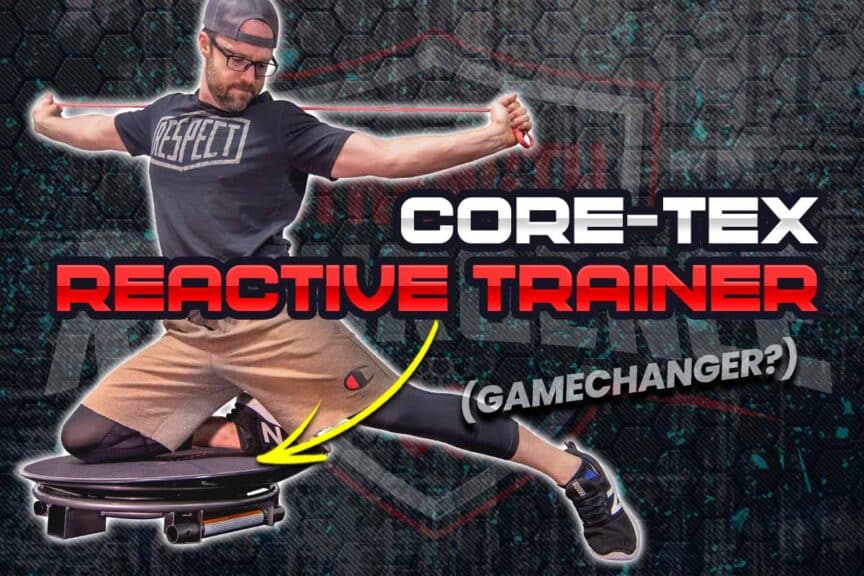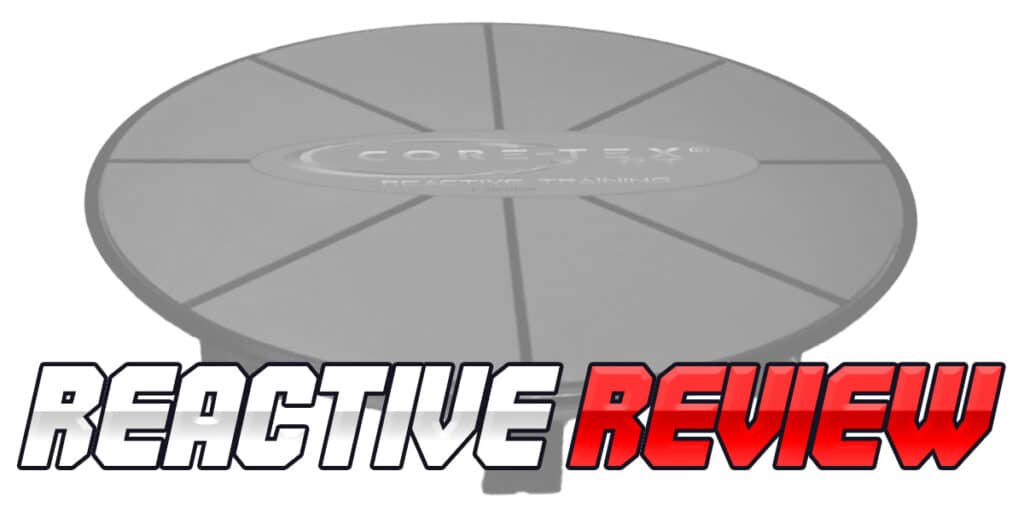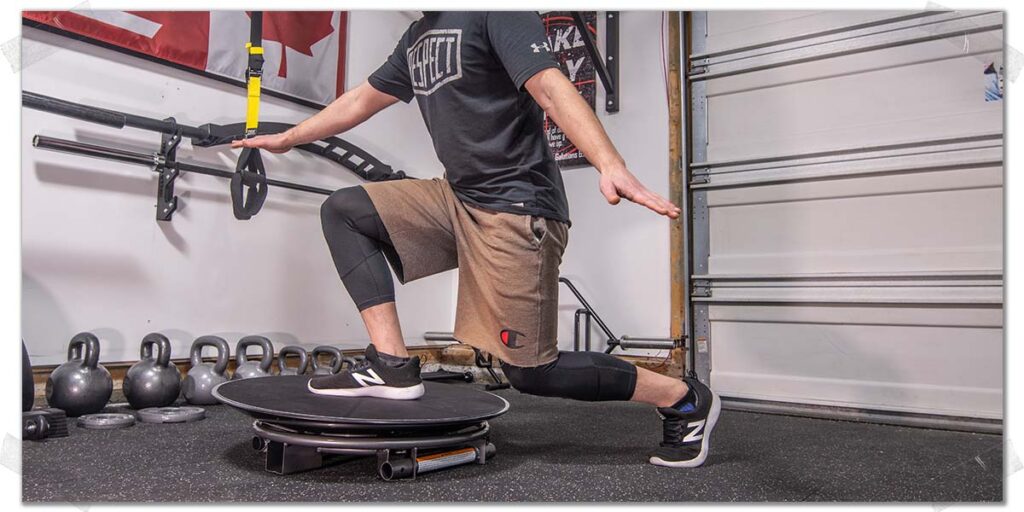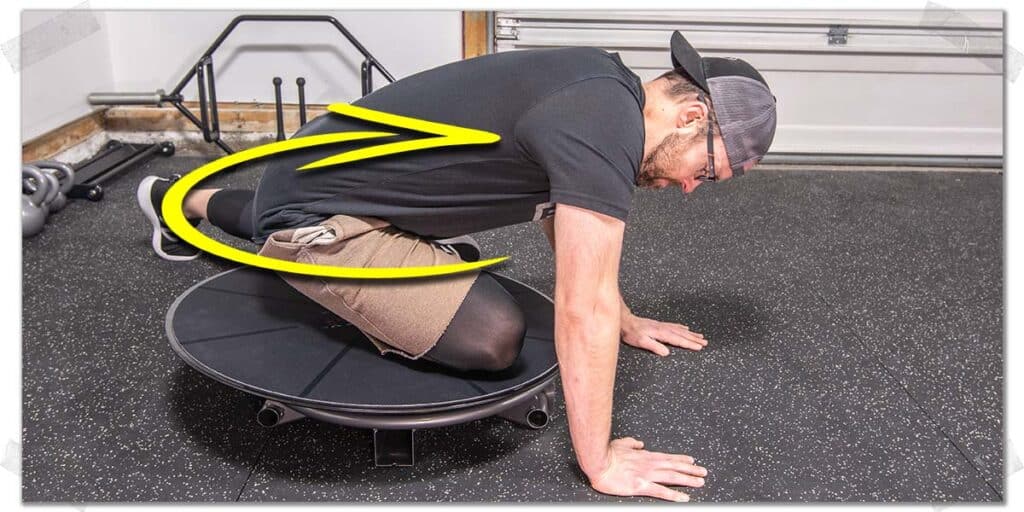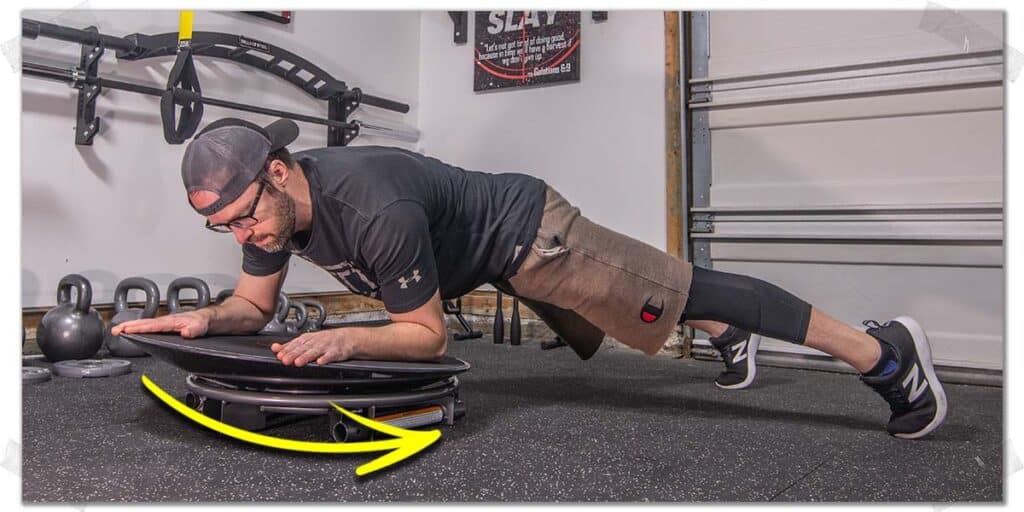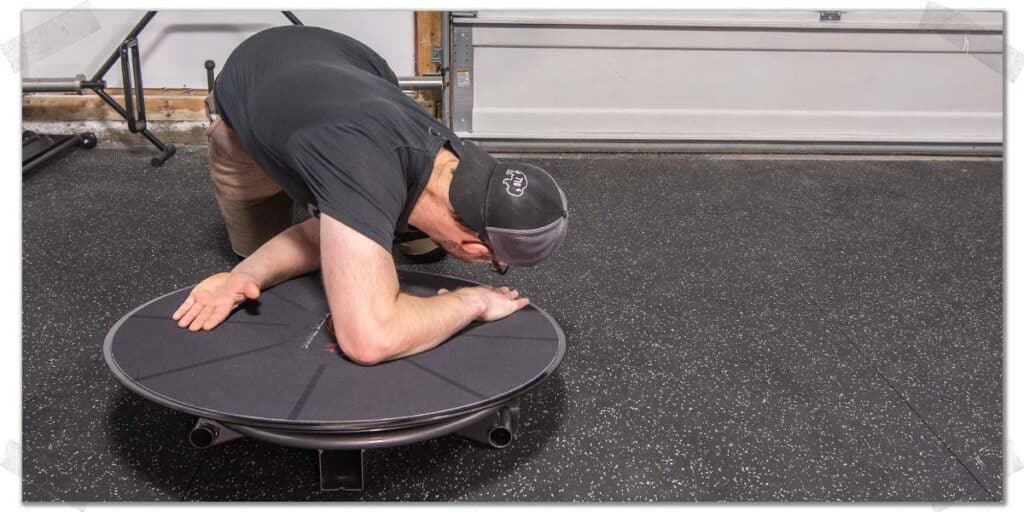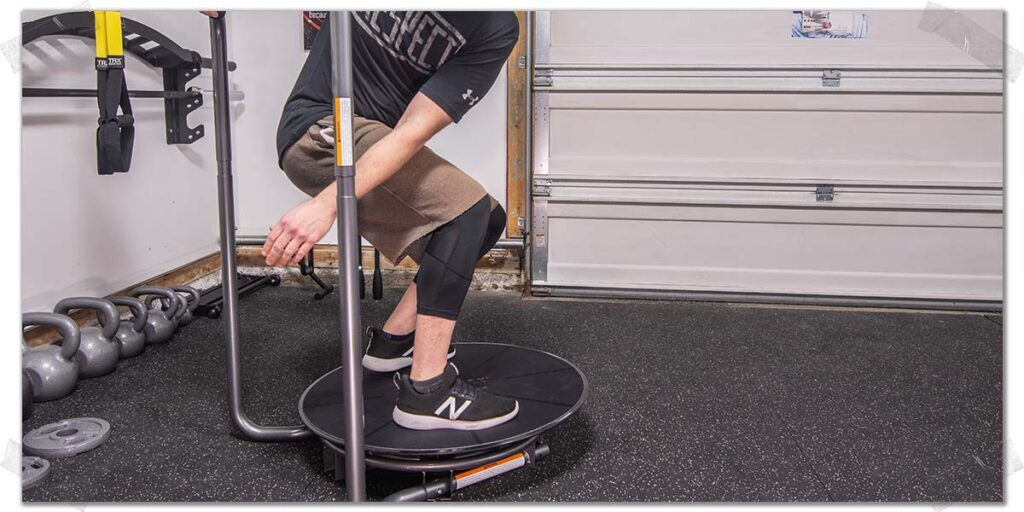You’re about to get detailed insight into an incredibly unique piece of equipment that is basically a Swiss Army Knife for optimizing numerous aspects of human movement.
It’s known as the Core-Tex Reactive Trainer. I bought it a few months ago and have been putting it through its paces, and…let’s just say it offers some very unique features we need to talk about.
As a physical therapist and strength & conditioning specialist who is obnoxiously passionate about helping patients and athletes overcome injuries and maximize their physical performance, I’m always on the hunt for equipment that can make a difference in their lives.
So, when I came across the Core-Tex Reactive Trainer, I saw significant potential for my patients, my athletes, and even myself. So, I took my hard-earned cash, bought one, and am passing my findings on to you in an attempt to help you live a stronger life while being an informed consumer in the process.
There’s some important information to unpack here, so let’s get to it!
Disclaimer: All thoughts and opinions in this article are my own. I purchased my Reactive Trainer with my own money. I have since picked up an affiliation with Core-Tex after being comfortable putting my name behind this product. I wouldn’t have done so if it wasn’t up to my standards.
If you’d like to support this website and are considering picking up a Reactive Trainer for yourself, you can click on this link right here (it takes you to the Core-Tex website), which is an affiliation link, meaning it will provide me with a small commission at no extra cost to you.
And while we’re at it, if you find value in this article, please consider sharing it on your favorite social platform!.
What is the Core-Tex Reactive Trainer?
If you’re not familiar with this device, here’s the quick rundown:
The Core-Tex Reactive trainer is a dynamic platform resting on a steel frame with ball bearings, allowing completely unrestricted movement to occur in any plane.
And… that’s all it is. Simple enough, right? Well, not quite. You see, it’s not about what this device is but rather what it allows you to do, which is an entirely different story.
Related article: Challenging Ankle Stability Exercises: No Equipment Required!
What does the Reactive Trainer let you do?
So, what do you do with this Reactive Trainer? Well, in short, just about anything you want when it comes to creating a dynamic training surface for your body, which can be invaluable for injury rehabilitation or performance-based training. So, a single device that can be used for either of these populations means we’re off to a good start here.
With either injured or non-injured populations, this dynamic platform can be utilized in ways that allow you to elicit various training adaptations for the body. Essentially, we can divide these training adaptations into a few different categories.
Category 1: Neurosensory Adaptations
The first category is neurosensory adaptations, meaning we’re enhancing how our brain perceives — and thereafter — responds to the sensory information it’s receiving from the body part or body parts that are being challenged by the dynamic platform.
These neurosensory abilities include components such as joint proprioception, kinaesthesia, and motor control strategies. Now, I’m not going to go into these neurosensory details here, but for the sake of this video, just know that ultimately, this means we’re enhancing how the brain and body talk to one another via the nervous system.
These adaptations arise from the real-time sensory information the brain receives from the body and the corresponding motor adjustments the brain must then send back to the body, all of which happen through the nervous system.
“With either injured or non-injured populations, this dynamic platform can be utilized in ways that allow you to elicit various training adaptations for the body.”
Category 2: Musculoskeletal Adaptations
The second category is musculoskeletal adaptations, meaning you can perform movements that help improve joint mobility and range of motion, movements that stretch muscles and fascia, and exercises that increase muscular strength and endurance.
I imagine you’re now starting to see why I’m making the analogy that this dynamic platform is analogous to a Swiss Army Knife — it’s a single device that gives you a wide variety of diverse training tools to work with without being a massive or cumbersome object.
Related article: Practical Fitness Equipment To Pack When Travelling (Budget Friendly)
Category 3: Cardiorespiratory adaptations
Depending on how you use the Reactive Trainer, you can even enhance cardiorespiratory fitness, meaning it can strengthen your heart and lung function. This means we have a third category for health and fitness adaptations it can foster.
There’s a research article that has found the Core-Tex reactive trainer to elicit some of these changes, which is pretty neat. I’ve provided the link to it in case you want to read up on it:
Article: The Acute and Chronic Responses to Exercise with the Core-Tex™
So, the fact that we’ve got a highly versatile device that can be used for injury rehabilitation, injury prevention, or even sports performance training is really valuable for someone like me. But it doesn’t stop there.
Exercise Versatility: Using the Reactive Trainer
Regarding the exercises this device affords, there’s no shortage of movements to perform. Whether it’s lower-body or upper-body exercises, core exercises, or full-body exercises, you can take foundational movements and stick with those or build upon them in ways that best suit your needs.
And I’d imagine by now, you can start to see why I believe this is really cool and something worth talking about!
Why not use a BOSU Ball instead?
Now, I can hear some of you already, “But Jim, just get a BOSU ball, and you can do the same thing!”
My response: Nope, you can’t.
A BOSU ball is certainly a good piece of equipment to have on hand, and it can replicate a few aspects of the Reactive Trainer, but it doesn’t offer any transverse-plane movement, which significantly limits the movements and exercises you can perform.
To be clear, I’m not trashing BOSU here; rather, I’m pointing out that it’s not a true apples-to-apples comparison between the BOSU ball and the Reactive Trainer.
Quality and Construction of the Reactive Trainer
Ok, so we now know what the Coretex Reactive Trainer does, but that’s all on paper. How does it actually stack up in the real world? What’s the quality like, and how does it feel to use? Those are great questions to ask, so let’s unpack all of this one thing at a time.
When I received my Reactive Trainer, I set it up and was initially a bit underwhelmed, as the bearings were not rolling in a smooth manner at all.
They weren’t horrible, but they were certainly not providing the movement that the instruction manual said they should, and I could certainly feel —and hear — annoying resistance when performing nearly any exercise on the platform. So, this was indeed problematic.
So, I picked up some TriFlow oil (the bearing lubricant that the folks at Coretex recommend), and I followed along in their provided instructional video to see if I could get these things to be as frictionless as they ought to be.
Since these bearings were brand new, I didn’t wash them as shown in their cleaning video. Instead, I went right for the oil, and after three or four drops in each casing, this thing was sliding and gliding in butter-smooth fashion. (Seriously, I was shocked by the improvement this oil made to the bearings)
Pro tip: as time goes on, you’ll need to have some of this oil on hand, as bearings will always require maintenance and cleaning due to the dirt and debris they can collect with continued usage.
Regarding the TriFlow oil (affiliate link to Amazon), I knew I’d need to have it on hand and use it at some point, but it was disappointing to have the Reactive Trainer’s bearings arrive in this condition.
Thankfully, the bearings not arriving in ideal working order was a minor and short-lived issue, and that’s the only real issue I’ve had; everything else about the Reactive Trainer has been operating as expected.
As for the overall construction of the device, it’s quite solid. And what I like is how there aren’t exactly a lot of intricate or moving parts with this device, as there are fewer parts that can break or wear out as time goes on. So, I feel it will hold up quite well to the tests of time.
A quick note on the handrail
I want to quickly point out that I do find myself wishing that the railing — which is removable — was a bit more sturdy. It’s not that I fear that it will give way and that I don’t trust it — I trust it is just fine. Rather, I find the small wobble it can produce can be a bit distracting when using it for various exercises, which I need to keep in mind when having my patients and athletes use it for their exercises.
Who Should Consider Using the Reactive Trainer?
This is where the appeal of this device really shines, at least for me; you can have young or elderly individuals use it, and every age in between as well. And for any of those individuals, you can have them use the Reactive Trainer for various aspects of:
- Injury rehabilitation
- Injury prevention
- Sports performance
So, we’re talking massive demographic versatility.
“If you’re looking to add some training versatility into your home exercise pursuits, I’d consider the Reactive Trainer to be a worthy piece of kit to add to your home studio or gym if it fits your budget and suits your training needs.”
In that regard, it reminds me of the TRX, which is arguably my favourite Swiss Army Knife piece of fitness equipment of all time. It’s like the TRX and the Reactive Trainer are two Swiss Army Knives with unique tools offered by each.
Related article: How (And Why) To Use A TRX For Injury Recovery: A Detailed Guide
Between these two pieces of kit, I have a world of movement challenges and opportunities I can provide those I work with for treatment and training.
Is the Reactive Trainer a Good Purchase?
If you have access to a Reactive Trainer at your gym or fitness studio, it can certainly be worth using. And if you’re looking to add some training versatility into your home exercise pursuits, I’d consider it to be a worthy piece of kit to add to your home studio or gym if it fits your budget and suits your training needs.
Not every home gym owner or fitness enthusiast will need to pick one up, but for those who are looking for a piece of dynamic equipment for their training needs, it can be an outstanding piece of kit to have.
Regarding its price point, when looking at the versatility of the Reactive Trainer and what it can offer, for me, it’s a piece of equipment I’m happy I’ve invested in. Price is always what you make of it, and while I will always advocate that you stay within your budget if you’re someone who has the resources and is simply wondering if this piece of equipment is worth it, I’d say it certainly is.
But again, please stay within your budget. If you’re looking for a versatile and similar piece of kit but are on a tight budget, a BOSU ball can be a good starting point. While I focus on physical health here on this channel, I will always advocate for you to focus on your financial health as well.
Final thoughts
The reactive trainer is one of those pieces of kit that can really get the job done when it comes to attacking multiple facets of human movement through the challenges it provides. It’s honestly a great piece of equipment for someone like me who works with a variety of individuals for health and performance-based training.
So, I’m thrilled I’ve now got one more way to help get the job done when it comes to helping others live the stronger, healthier lives they want to live.
Now, if you want to read up on another cool piece of gear I’ve reviewed, you can check out this article right here, where you’ll learn all about what makes this particular piece of equipment extremely unique in the world of injury prevention and rehabilitation.
So keep making great things happen, and I’ll see you over there in the article.

Hi! I’m Jim Wittstrom, PT, DPT, CSCS, Pn1.
I am a physical therapist who is passionate about all things pertaining to strength & conditioning, human movement, injury prevention and rehabilitation. I created StrengthResurgence.com in order to help others become stronger and healthier. I also love helping aspiring students and therapists fulfill their dreams of becoming successful in school and within their clinical PT practice. Thanks for checking out my site!

